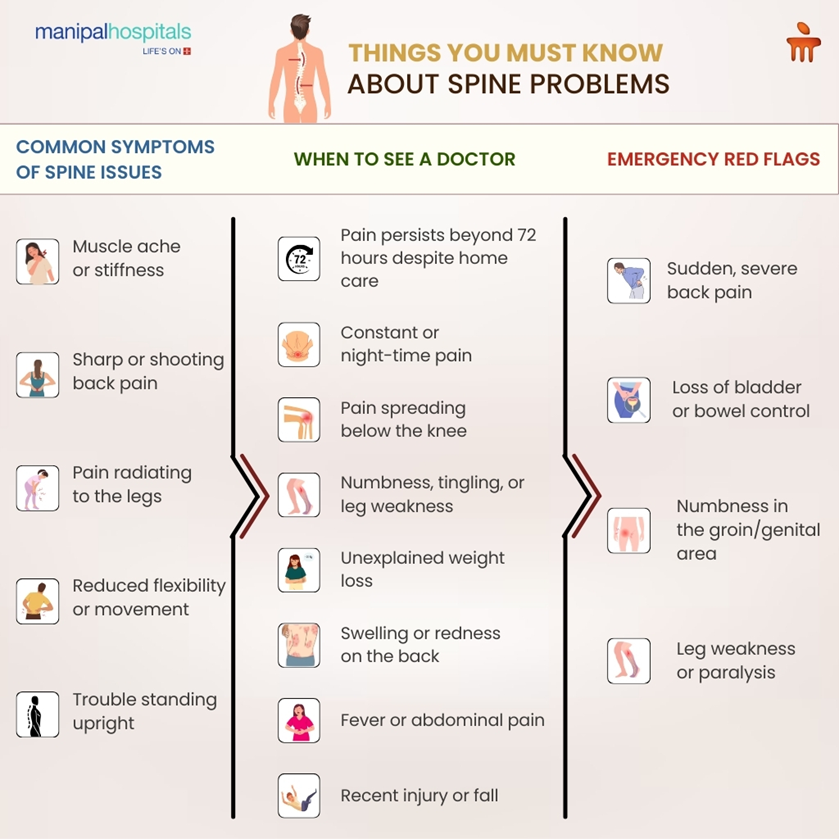
Spinal disorders and back problems are among the leading causes of chronic pain and functional limitations in adults. Different factors, such as poor posture, injuries, and spinal conditions, jointly affect the well-being of the spine, thereby creating discomfort and disability. Early identification of symptoms and appropriate spinal treatment are key to preventing disease progression and avoiding short-term complications. In this blog a leading spine care specialist in Varthur Road, Bangalore, provides comprehensive information about preserving spinal health.
Synopsis
What Causes Back and Spine Problems?
Structural, mechanical, and lifestyle factors may be the root cause of spinal problems. Identifying the core causes of spinal health issues leads to successful treatment, diagnosis, and planning.
The following list includes the primary causes that lead to spinal conditions:
-
Poor Posture: Poor posture over time can compromise spinal alignment and musculoskeletal integrity, leading to chronic pain and long-term spinal complications.
-
Degenerative Disc Disease: Degenerative Disc Disease becomes prevalent with age since spinal discs deteriorate, leading to spinal conditions that need continuous treatment and impacting mobility and stability.
-
Injuries or Accidents: Scientific evidence shows that events such as motor vehicle accidents, sports accidents, and injuries to spinal discs or vertebrae can generate severe back and spine conditions demanding surgical intervention.
-
Herniated Discs: A herniated disc can compress adjacent nerve roots, causing severe pain, limited mobility, and potentially contributing to chronic spinal disorders.
-
Arthritis of the Spine: This leads to inflammation and stiffness in spinal joints, impairing spine health and requiring long-term spinal treatment for symptom management.
-
Obesity and Sedentary Lifestyle: Excess weight and inactivity strain your spine and weaken core muscles, contributing to an unhealthy spine and increasing your risk of chronic spinal conditions.
Common Symptoms of an Unhealthy Spine
Early recognition of spinal health issues can prevent serious complications and facilitate timely intervention and treatment. Here are key symptoms that may signal developing spinal conditions:
-
Chronic Back Pain: Ongoing discomfort or sharp pain in the lower or upper back indicates spinal conditions requiring medical evaluation.
-
Radiating Pain or Numbness: Pain that travels down the arms or legs points to nerve compression caused by back and spine problems, such as herniated discs.
-
Limited Mobility: Difficulty bending, twisting, or standing upright could indicate stiffness or structural issues impacting your spine health.
-
Tingling or Muscle Weakness: Weakness or numbness in the limbs may be due to nerve impingement caused by severe spinal conditions that need targeted spinal treatment.
-
Persistent Neck or Shoulder Pain: Discomfort in the upper spine, neck, or shoulders may result from degenerative spinal conditions or prolonged poor posture.
-
Frequent Headaches: Cervical spine problems can lead to tension headaches or migraines, which are often missed as signs of an unhealthy spine.

Red Flags: Seek Immediate Medical Attention
Specific symptoms associated with spinal conditions require urgent care to avoid permanent damage.
Watch for these red flags and seek immediate help if you experience:
-
Loss of Bladder or Bowel Control: This could indicate cauda equina syndrome, a rare but serious condition linked to severe back and spine problems requiring emergency spinal treatment.
-
Sudden Weakness in Legs: Rapidly progressing weakness may indicate spinal cord compression, a serious condition that can significantly compromise mobility if not treated promptly.
-
Severe Pain After Trauma: If back pain follows an accident or fall, it could suggest fractures or nerve injury that severely impact spine health.
-
Fever with Back Pain: This combination may indicate a rare but dangerous spine infection that needs urgent treatment.
-
Sudden Numbness in the Groin Area: Known as saddle anaesthesia, this alarming symptom points to nerve damage from severe back and spine problems.
-
Unexplained Weight Loss with Pain: Significant weight loss alongside persistent back pain can be a red flag for tumours or infection in the unhealthy spine.
Treatment Options for Spinal Conditions
Managing spinal conditions involves various treatment approaches based on the diagnosis, severity, and impact on daily life. Here are common and effective spinal treatment options:
-
Physical Therapy: A personalised exercise programme strengthens spinal muscles and restores mobility, improving spine health and reducing dependence on medication.
-
Pain Management Medications: NSAIDS, muscle relaxants, or nerve pain drugs are prescribed for relief from pain caused by back and spine problems.
-
Chiropractic Adjustments: Manual spinal manipulations can improve alignment, reduce nerve irritation, and support healing in mild spinal conditions.
-
Minimally Invasive Procedures: Techniques like epidural injections or nerve blocks provide targeted relief and are helpful for patients with moderate spinal conditions.
-
Surgical Intervention: When conservative measures fail, surgeries like spinal fusion or disc replacement may be needed for lasting spinal treatment.
-
Lifestyle Modifications: Regular activity, ergonomic changes, and weight management are key in preventing and managing back and spine problems.
Conclusion
If left untreated, spinal and back disorders can cause significant pain and progressively impair quality of life. By understanding the causes, recognising symptoms, and being aware of emergency signs, you can seek the proper spinal treatment in time.
Always pay attention to your body’s signals and consult a top spine specialist.
FAQ's
Yes, poor posture over time can lead to permanent misalignment and chronic spinal conditions if not corrected early.
Persistent pain, stiffness, numbness, and reduced flexibility are strong indicators of an unhealthy spine needing attention.
Not all, but many back and spine problems can be managed with non-surgical spinal treatments like therapy, medication, or injections.
If pain lasts over a few weeks or if you notice red flag symptoms like weakness or bladder issues, consult a specialist immediately.
Exercise regularly, maintain good posture, avoid prolonged sitting, and use proper lifting techniques to protect your spine health.





















 5 Min Read
5 Min Read













